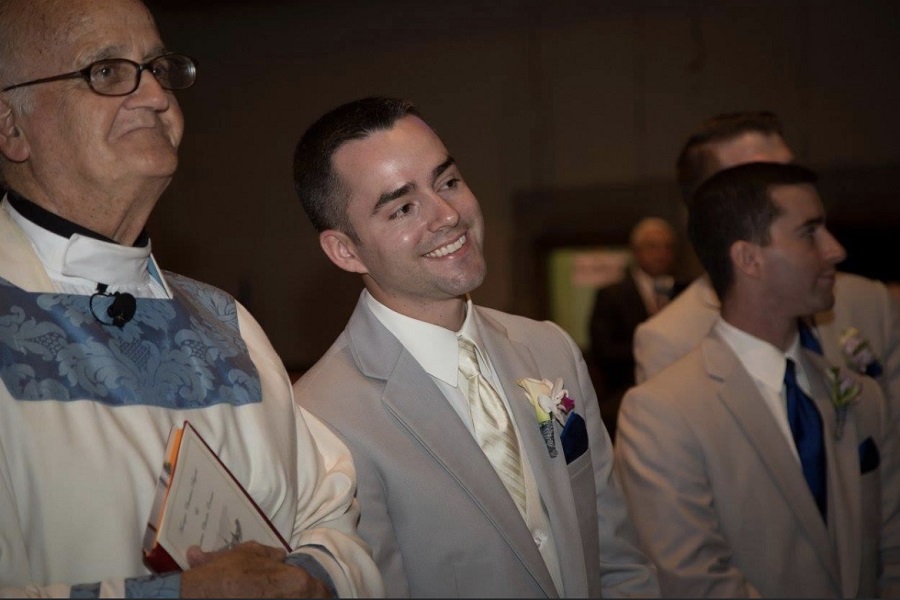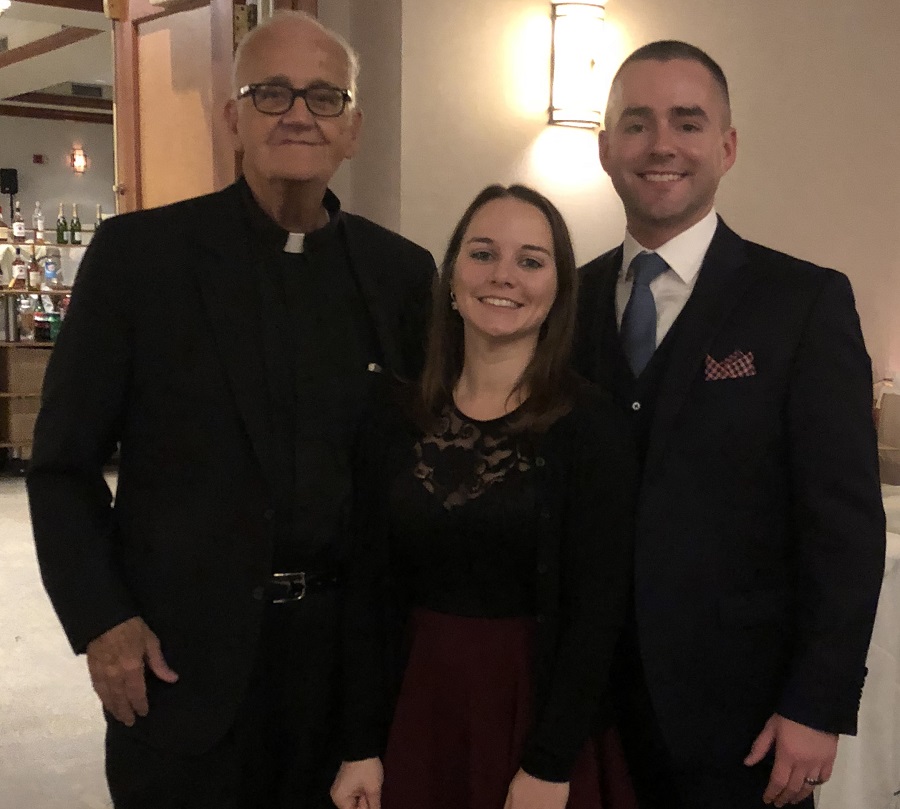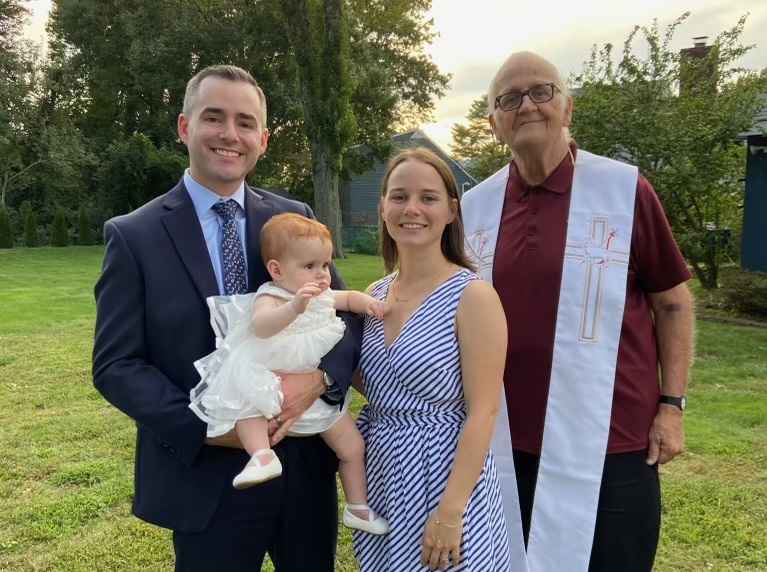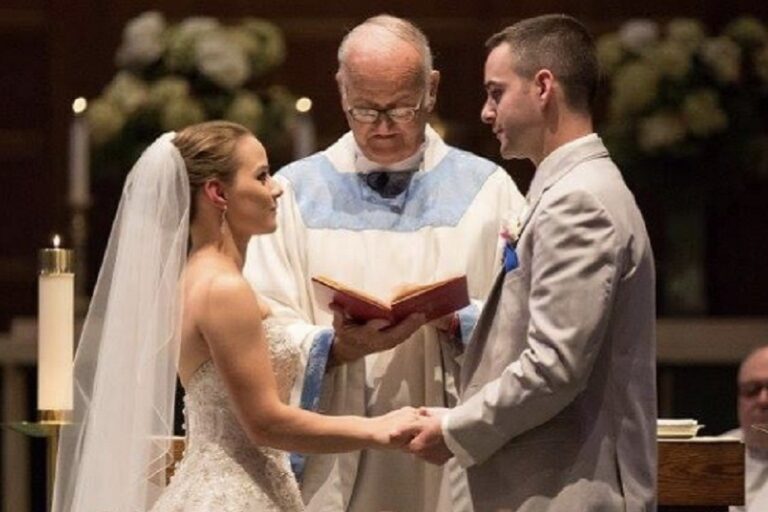My friend Andrew Cevasco wrote this beautiful tribute to Rev. Anthony Azzarto, S.J., who served at St. Peter’s Prep in Jersey City, New Jersey, for 60 years. Andy is the director of undergraduate admission for Loyola University Maryland (where I also work), and he and his wife, Monique, are Loyola graduates who were married in Loyola’s Alumni Memorial Chapel. The Cevascos live in Baltimore with their two daughters. I thought this was a beautiful piece that shows the tremendous impact an incredibly pastoral priest had on so many lives. Thank you, Andy, for giving us a glimpse into who Fr. Anthony Azzarto was and for letting me share your words here.
~~~
“If pictures say a thousand words…then what do a thousand pictures say?”
If I close my eyes, I can still see the first time I walked through Mulry Hall. I was in 8th grade. The hallway was covered with 4×6 photographs that were stuffed into 2×6 plastic sheets (like a collection of baseball cards) and then thumbtacked and taped to every inch of the walls and ceiling. It looked like something out of Hogwarts.
My brother, who was giving me a behind-the-scenes tour of my future high school home, reached out his hand for a doorknob that just barely jutted its way through the collage, like a sapling fighting through the fallen leaves on a forest floor.
As the door swung open, there stood a man among a photo collection that covered every inch of his classroom—from the walls to the ceiling to the vinyl roller window shades. Pictures. Pictures, upon pictures, upon pictures.
He was grinning with a closed-lipped smile and had a hand already extended to shake my own.
I didn’t know it then, but that man would change the trajectory of my life, as he did for thousands of other students who were fortunate enough to pass through the halls at Grand & Warren.

Fr. Anthony Azzarto, S.J., passed away this past Saturday at the age of 84. He was a Jesuit for over 60 years and a stalwart at my high school, St. Peter’s Prep, for more than 30. It was Prep folklore that Fr. Azzarto could show up at multiple events (at the same time) on the same day—from a JV cross country race, to a varsity wrestling match, to a freshman basketball game, to a theater rehearsal.
Once he was at an event, with a quick, “alright, get together now” he would pull out his camera and snap a photo. A photo he’d develop in duplicate (and years later finally be convinced to go digital) and would have enough copies made to mail to each person in the picture—with one extra to add to his own collection. They’d be hastily stuffed into an envelope, loosely labeled with an address, and accompanied by an indecipherable handwritten note, then whisked away to the post office.
I was the beneficiary of many of those Azzarto care packages and have my own compilation of photos to prove it.
It was in that classroom that Fr. Azzarto would teach thousands of students countless lessons. Yet at the root of his teachings was one seemingly simple concept that dates back over 480 years to St. Ignatius himself, In Omnibus Quaerant Deum, which translated from the original Latin means, “in all things let them seek God.” Put more simply, “Finding God in All Things.”
Though that phrase was based in the history of the Jesuits and rooted in Catholicism, the reason Father endeared himself to students of all faiths and backgrounds was because the theory itself is universal. Finding God—goodness, beauty, joy, happiness, grace—in all things, at its base, is a lesson in mindfulness, in being present in the moment, in realizing and appreciating God’s presence in your life, but perhaps most of all, in those around you.
Fr. Azzarto would go on to teach that God was not just hanging on a crucifix on the wall but was in the laughter shared among soccer teammates, the act of service to a person experiencing homelessness, the sunrise caught in the dew on an early morning blade of grass, or the flicker of a candle on a retreat weekend.

One of his favorite things to do in a homily was to pull a crumpled Jersey Journal article out of his back pocket and through a sermon consisting of a series of short bursts somehow relate it back to the Gospel. Finding God in All Things.
Truth be told, this past Saturday was not the first time I felt I lost Fr. Azzarto. Following my sophomore year at Prep, Father accepted the call to head back to Nigeria. It would be his second stint in Africa and as a rising Junior in high school who selfishly didn’t want him to leave, I was devastated. I began a tradition that year, that would end up lasting the next two decades, of writing emails to Father to check in. I’d share moments going on in my life and he’d reply back with advice and words of encouragement—one quick quip at a time.
Learning that Father was released from the hospital on hospice two weeks ago broke my heart. But it also gave me the chance to reflect and go back through old letters, emails, and photos that I had from him—from the events he presided over, like my wedding and the baptism of my daughter, Emma, to the moments he just checked in to see how I was doing. I combed through them, considering dates, timestamps, and what was going on in my life.
Slowly pouring over those notes, I realized how important each one of those touchpoints was for me. Whether I told him something firsthand or he learned about me through the grapevine, Father had the impeccable timing of finding me exactly when I needed him.
He got excited for me when I was accepted into the Jesuit Volunteer Corps, when I landed my first job at Loyola, and when I got my most recent promotion. He celebrated with me the moment I got engaged to the love of my life, the first anniversary of our wedding, and when he found out Monique was pregnant. He mourned with me when he learned about the passing of my Grandmother, and then did it again the following year with the passing of my Aunt. And he grieved with me after we lost my son Andrew Luke prematurely, traveling down to Baltimore to preside over his memorial Mass.
The prime example of his thoughtfulness, empathy, and compassion was a simple email on March 2, 2020, one year after Andrew’s passing. Completely out of the blue Father wrote: “Hello from the Bronx. March 2 a very emotional day for you both. Eternal life for Andrew Luke but a heart of tears for you both and all who know you. I have the 11:30 Mass here in the Bronx and will remember all three of you. His picture is on my wall and in my pocket.”
With everything going on in his world, how did he even remember the date? How did he think to do that? How did he know what to say? Somehow, time and time again he just knew. And to be perfectly honest, the thing I am going to miss most going forward is knowing I won’t receive those little check-in emails or handwritten notes any longer. Knowing that these future events—from the baptisms to the funeral Masses—will be missing his familiar homilies and the flash of his camera is a hard pill to swallow.
It’s hard to imagine going through life without him. But what’s most amazing about Fr. Azzarto’s legacy is that I am just one of his students—the Cevasos are just one family (three Prep grads)—and there are thousands of other students he’s cared for the same way.
Reflecting back on it now, I’m touched by the moments he reached out to me, but also realized all the times he asked me to look out for someone else. He’d give me a heads up about a classmate who lost a parent, he’d ask me to say a prayer for a family going through an illness, he’d have me reach out to an incoming first-year student new to Loyola, or ask me to talk to a student who was thinking about transferring colleges.
I have no idea how he kept all of this information straight (I feel fairly confident it wasn’t a detailed filing cabinet), but somehow, he just always knew how and when to appear.
Time and time again he was not only there for me but he called on me to be present for someone else.
Father was fond of the poetry of Gerard Manley Hopkins, and in one of the old emails I found he cited “As Kingfishers Catch Fire.” He often quoted the final lines, and in fact, included them in his remarks when he was celebrated as a Legend of Prep:
…for Christ plays in ten thousand places,
Lovely in limbs, and lovely in eyes not his
To the Father through the features of men’s faces.
For the man who taught countless students over multiple generations the idea of finding God in all things (and lived that value every day of his life) the simple fact remained that the place he found God the most was in others—in “men’s faces.”

In me. In my family. In my son. In my beautiful daughters. In you.
In reflecting on his life, it brings me solace to realize that over and over again he showed up to places knowing that he found God—found joy, found happiness, found grace—in the people with whom he surrounded himself. What a beautiful mosaic of memories he created throughout his 84 years. The physical manifestation of which was found in the thousands upon thousands of photos—capturing thousands upon thousands of faces—that he surrounded himself with from the 3rd Floor of Mulry to his room at Murray-Weigel.
Thinking back on his impact on my life, I remembered a phrase I came up with that ended up being the opening line to my own college essay: “If pictures say a thousand words…then what do a thousand pictures say?” I then went on to write that essay about Fr. Azzarto and his impact on Prep.
It’s not lost on me that all these years later, I ended up attending a Jesuit institution, working in the admission office, and reading thousands of college essays.
I feel it’s only fitting to end this note the same way I ended my college essay.
“If pictures say a thousand words…then what do a thousand pictures say?”
The answer is simple: “Love.”
Written by Andrew Cevasco, photos courtesy of Andrew Cevasco
Copyright © 2023 Catholic Review Media


